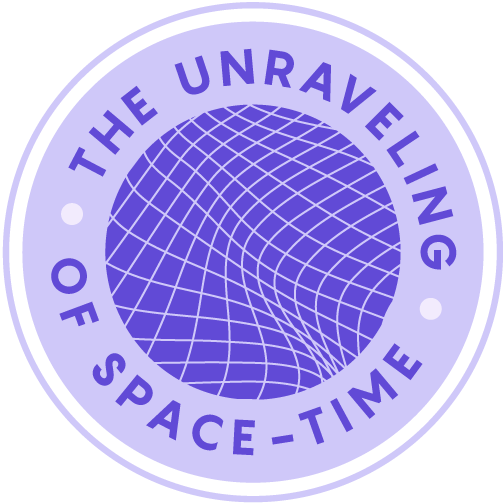John Wheeler Saw the Tear in Reality
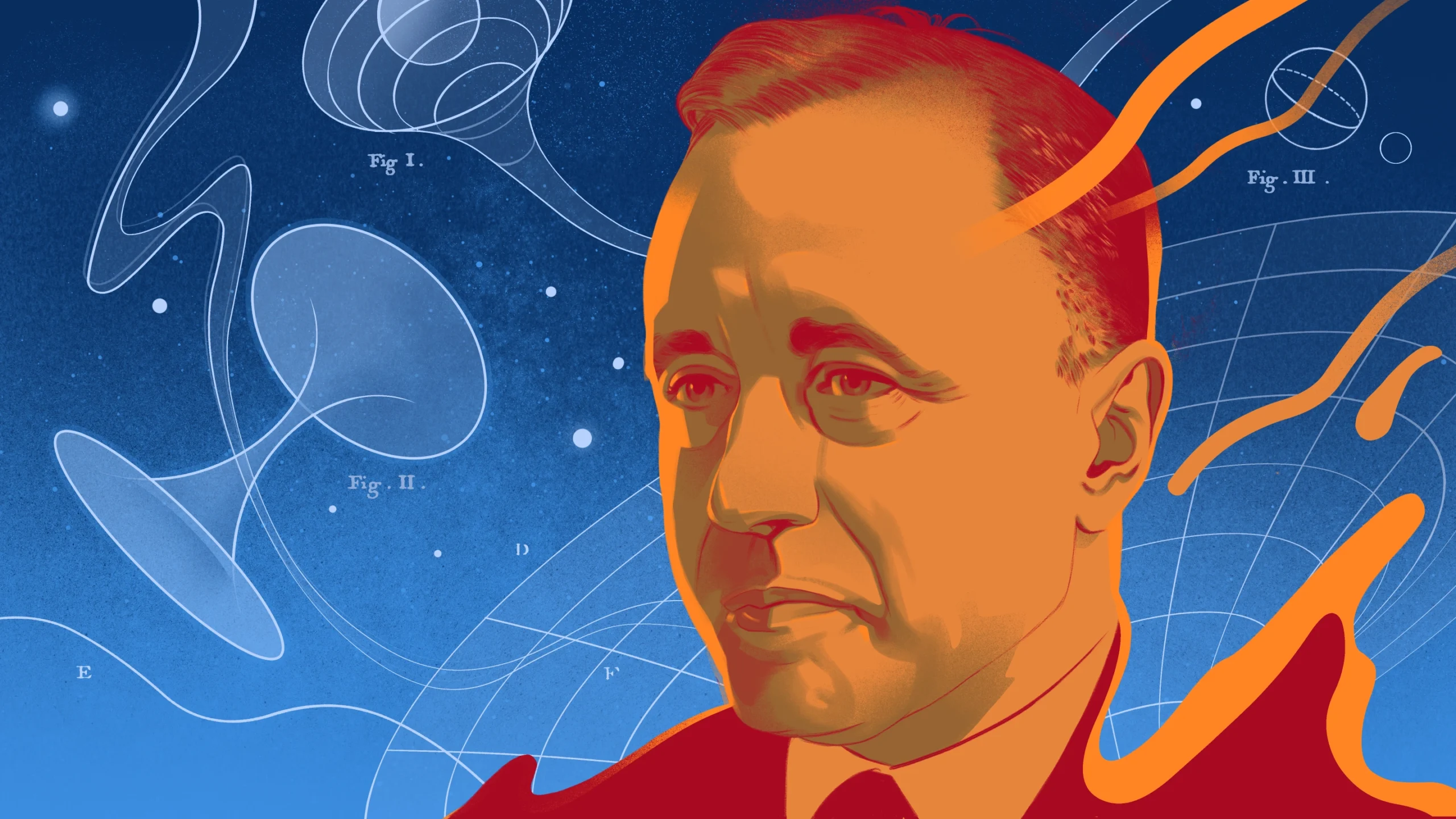
Señor Salme for Quanta Magazine
When Johnny Wheeler was 4 years old, splashing in the bathtub in Youngstown, Ohio, he looked up at his mother and asked, “What happens when you get to the end of things?” The question would haunt him for the rest of his life. What happens when you get to the bottom of space? What happens when you get to the edge of time? It would lead him to suggest that space-time can’t be the true fabric of the universe. It would compel him, even in his final days, to search for some deeper reality beneath space-time and to wonder whether, somehow, that reality loops back to us.
John Archibald Wheeler was a physicist’s physicist. He never won a Nobel Prize, never became a household name, but to those in the know, he was a legend. He broke ground in many areas of physics: particle, nuclear, gravitational, quantum. He studied under Niels Bohr, walked and talked with Albert Einstein. He was ambitious, to put it mildly, but it was never for personal gain. Wheeler wanted to solve the mysteries of the universe so that he could give answers back to his community. He had a motto: “Nobody can be anybody without somebodies around.” He spread his insights widely, letting his students shine. Richard Feynman, Hugh Everett, Jacob Bekenstein, Kip Thorne — they, among others, became luminaries in his glow. When a Princeton University donor offered to dedicate a physics building in his honor, Wheeler declined, saying the building shouldn’t be “focused on one person. Physics isn’t done that way.”
Throughout his career, which spanned much of the 20th century, Wheeler kept detailed journals — large, hardbound notebooks bursting with every insight, hunch, dead end and breakthrough. Those journals, now held at the American Philosophical Society in Philadelphia, reveal something remarkable: It was exactly Wheeler’s desire to put community first that shaped his struggle to understand the origin of space-time.

Wheeler’s preoccupation with space-time began in the 1950s. General relativity — Einstein’s theory that matter and energy warp space-time and that this warping is gravity — had fallen into the backwaters of physics, outshined by progress in quantum mechanics. But in 1952, Wheeler had an idea: What if what we call “matter” is really just space-time? After all, he thought, gravity is a kind of energy, but gravity acts on energy, which means gravity acts on itself. He imagined waves of gravity folding themselves into compact spheres that would look like elementary particles from the outside, while on the inside they’d be made of nothing but empty space, “mass without mass.” He called them “geons.” They would whittle down the ingredients of the universe to just one.
Particles also have charge. Could that, too, be reduced to geometry? Wheeler imagined a highly warped and twisted space-time, “multiply connected,” with holes and handles wrapping in and around themselves. Electric field lines woven through this gnarled landscape could disappear into one hole, burrow through space-time, then reemerge from another. Where they disappeared, it would look like there was a negatively charged particle, and where they reappeared, a positive one. In truth, there would be neither, just electric field lines endlessly looping back on themselves, creating “charge without charge.”
No one had ever used general relativity in this way, bending and contorting space-time until the rest of physics poured right out, rendering the universe full of strange twists and tunnels so new they didn’t have names. Wheeler gave them one: wormholes. That’s what he was best at —naming things, yes, but also taking preexisting theories and pushing them to their limits to see where they break. What happens when you get to the end of things?
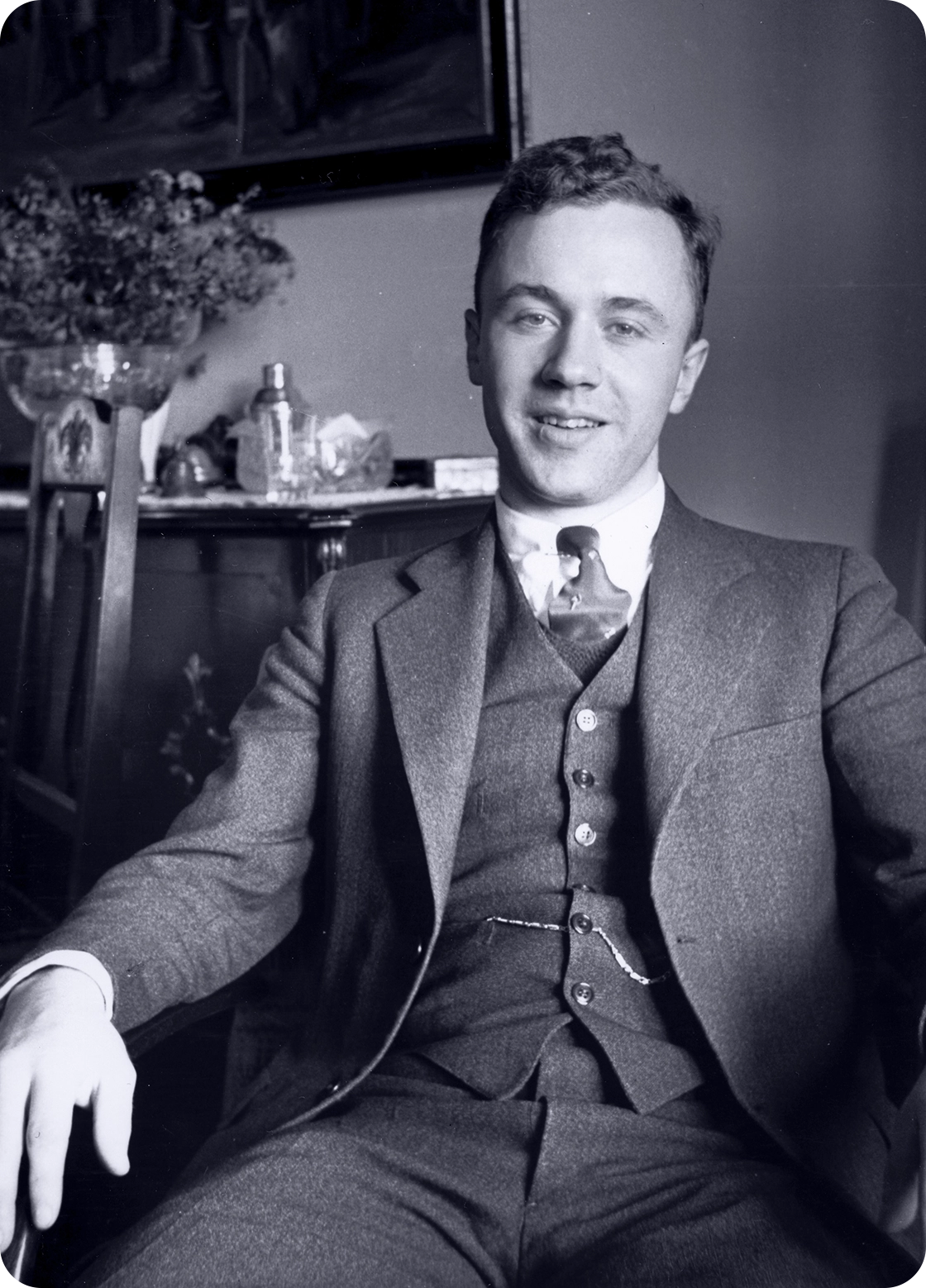
John Wheeler at age 23 in Copenhagen, Denmark, where he spent a year studying with Niels Bohr.
Emilio Segrè Visual Archives, Wheeler Collection
Everything in the universe made of space-time: Wheeler was captivated by the simplicity of the idea. But why should space-time have such wild terrain, and only at the scale of elementary particles? He guessed that quantum fluctuations of space-time could transform a tranquil geometry into a mangled maze, which Wheeler called “quantum foam.” It seemed to be just what was needed for geons to exist.
It then occurred to Wheeler that at scales smaller still — the infamous Planck length, on the order of 10-33 centimeters — quantum uncertainty could destroy space-time altogether. Localized points like “here” and “there” would be rendered meaningless. He wanted to build everything in the universe out of space-time, but it wasn’t clear if space-time would survive.

In 1960, Wheeler hit upon an unsettling fact: Wormholes are unstable. The tunnels would form and instantly collapse in on themselves, their walls caving in until they vanish in a point of infinite density and curvature, creating a fatal kink in reality known as a singularity. Physicists had encountered singularities before but only as errors in their equations. There were hints that stars, when they burn out and gravitationally collapse, could harbor singularities in their bellies, but no one quite believed it, or if they did, they figured they’d be rare. Now Wheeler saw that, thanks to quantum fluctuations, reality was riddled with them. The fabric of space-time, at its smallest scales, was loosely woven, chewed by moths, too flimsy to bear the weight of the world.
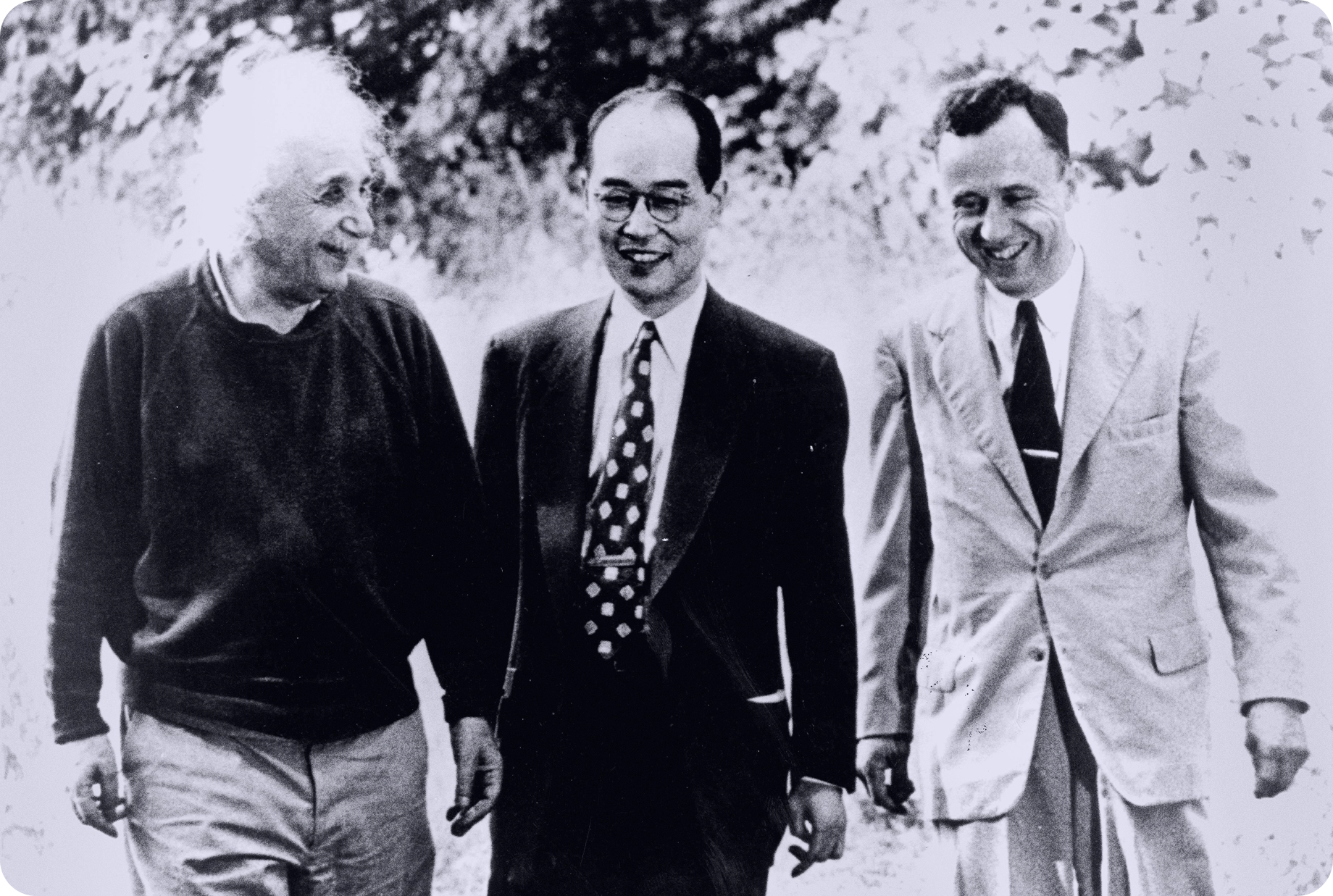
From left: Albert Einstein, Hideki Yukawa and John Wheeler in Princeton, New Jersey, in 1954.
Joseph Krumgold; courtesy of Johns Hopkins University
Yet here is the universe. It must be made of something. If space-time vanishes in the blink of a singularity, then something lays beyond or beneath. “More and more insistently at this point an issue clamored for attention,” Wheeler wrote. “Collapse to what?”
He decided to take a closer look at those burnt-out stars, buckled under their own weight with singularities in their darkness like pinholes in the world. Everyone kept referring to them as “completely collapsed objects,” but in 1967, at a talk at the NASA Institute for Space Studies in New York, Wheeler gave them a name that stuck: black holes. Once christened, black holes were taken seriously, both as objects that exist in reality and as places where reality ends.
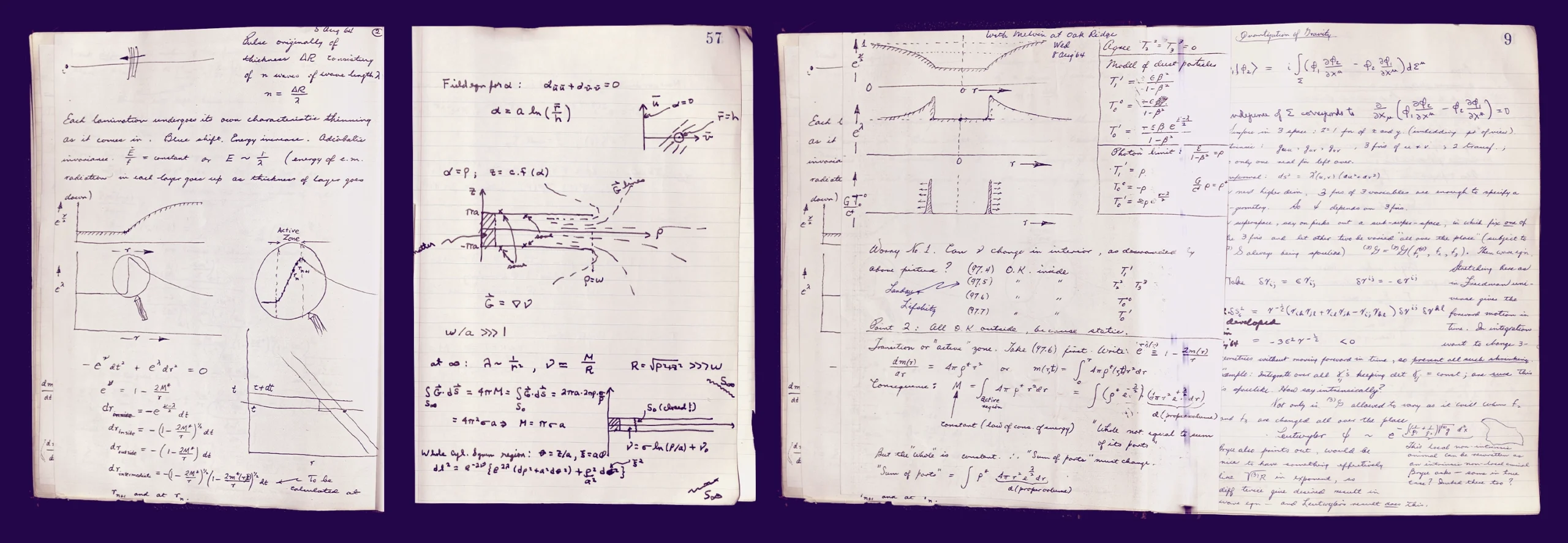
Pages of Wheeler’s journal from 1964.
American Philosophical Society
For the community, Wheeler’s work sparked a massive revival in general relativity. His textbook Gravitation, co-authored with his students Kip Thorne and Charles Misner, remains the bible of the field. For Wheeler, the work raised more questions than it answered. “Space and time themselves are transcended as categories, and the framework would seem to collapse for everything one has ever called a law, not least the concept of geometry itself,” he wrote. Beneath space-time, there had to be something else, some “pregeometry.” What happens when you get to the end of things? He was determined to find out.
In June 1973, he gathered up all of his general relativity books and papers — decades of work on space-time physics — and packed them away. Then he opened his journal to a fresh, blank page and wrote with resolve, “Starting a new hunt.”

Where to begin? With what? Those holes in space-time seemed to swallow everything. “No wonder I do not sleep well,” Wheeler scrawled in his journal. “The old simple universe fades, all is now in disarray.”
Could pregeometry be made of “grains” of space-time, he asked? No, that would assume too much structure.
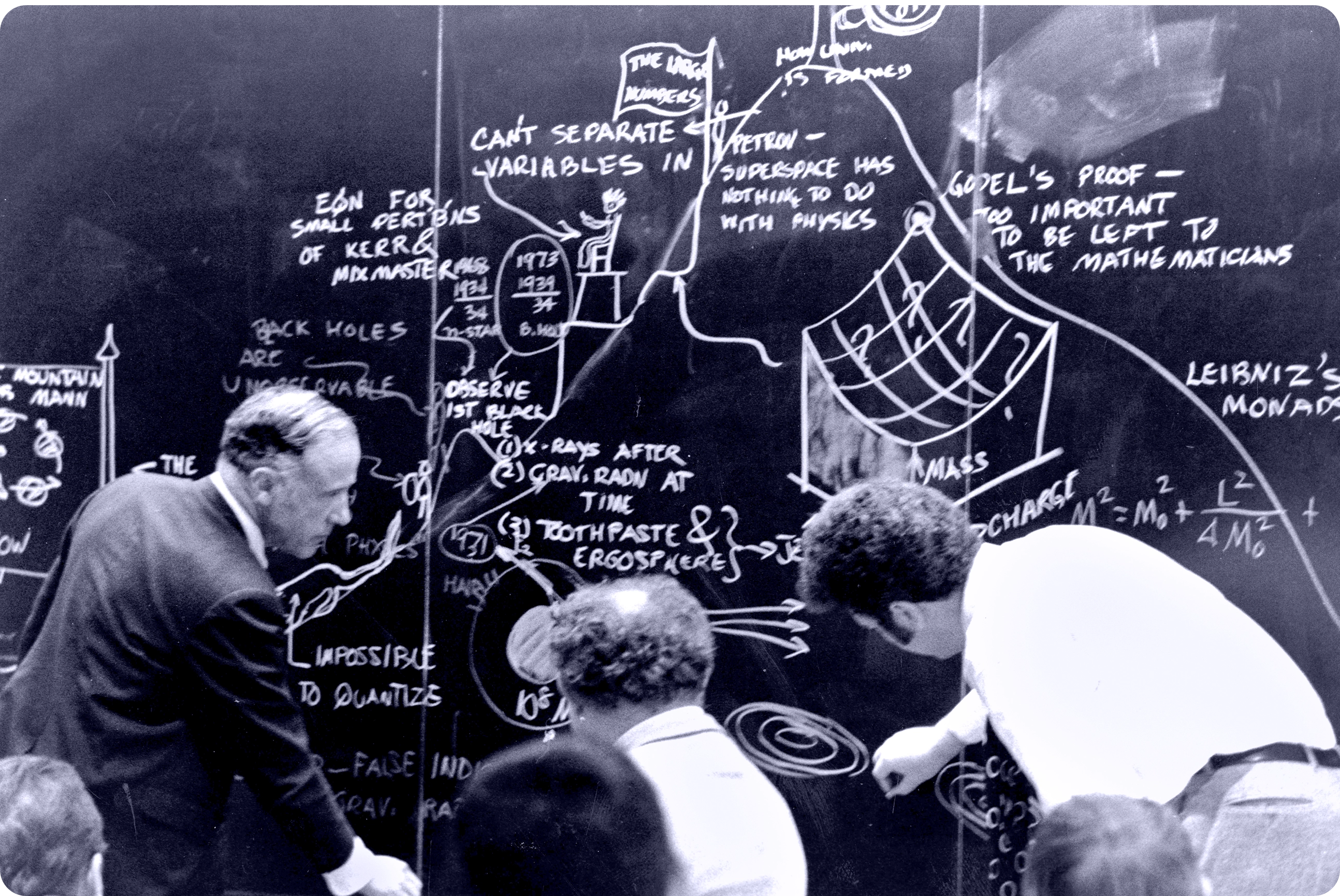
Wheeler (left) and his students worked at a blackboard in Princeton in 1970.
Robert P. Matthews; courtesy of Johns Hopkins University
He had a better idea: Perhaps it was made of information — 1s and 0s, yeses and nos, binary choices. “The dimension-free character of the bit at last frees us from the dimension-tyrannized land of … everyday physics of particles, fields, of space-time,” he wrote. But the question keeping him up at night was, whose information?
It dawned on Wheeler that when space and time went, taking the rest of physics with them, there was something left. “With law going and chaos arriving, one principle remains,” Wheeler wrote. “The quantum principle.” Quantum mechanics, he wrote, “destroys the concept of the world as ‘sitting out there,’ with the observer safely separated from it by a 20 centimeter slab of plate glass. Even to observe so miniscule an object as an electron, he must shatter the glass. He must reach in. … The universe will never afterwards be the same. To describe what has happened, one has to cross out that old word ‘observer’ and put in its place the new word ‘participator.’ In some strange sense the universe is a participatory universe.”
It was officially the wildest idea he’d had yet. A universe made not of matter, not of space-time, not of stuff at all, but of our choices. It wasn’t what he’d hoped to find; the physics had led him there. He’d pried up space-time, peered beneath, and found himself staring, to his bewilderment, at a mirror. “One finds himself in desperation asking if the structure, rather than terminating in some smallest object or in some most basic field, or going on and on, does not lead back in the end to the observer.”

In 1977, Wheeler gave a talk emphasizing that “no elementary phenomenon is a phenomenon until it is an observed phenomenon.” Afterward, the physicist Paul Dirac asked, “The formation of the solar system is a phenomenon. Is it only a phenomenon when it is observed?” Wheeler responded: “Yes.”
He had been thinking about the double-slit experiment, the infamously brain-melting proof that our commonsense expectations about the workings of the world can’t hold. Particles such as photons are sent through a screen with two slits before hitting a photographic plate on the other side. When both slits are open, the photons one by one build up an interference pattern on the plate, as if each photon had gone through both slits, wavelike, interfering with itself. But if we measure which slit a photon passes through, that interference pattern disappears. What we choose to measure matters.

Wheeler wanted to show something more: that it matters even when the thing we’re measuring already happened. What if we delay the choice to measure “which slit” until after the photon has passed through the screen? he asked. Could our measurement determine after the fact whether the photon went through one slit or two?
“I have got myself out on deep waters, in wanting to make something of ‘present choice influencing past action,’” Wheeler wrote in his journal.
In 1979, he described a doable version of the delayed-choice experiment in a lecture at the University of Maryland, and an experimentalist in attendance decided to carry it out. It took five years to get the experiment off the ground, but it worked. By choosing what to measure in the present, we participate in the creation of the past.
In the laboratory version, the choice is delayed by a mere fraction of a second, but in principle, there’s no limit to scaling it up. The photon might have been produced by a distant quasar and the role of the double-slit screen played by a galaxy whose gravitational field will deflect the photon leftward or rightward with equal probability. Does the photon travel both paths at once, creating an interference pattern on the photographic plate waiting here on Earth? Or does it travel only one path? It depends on if an Earth-based astronomer — here, now — decides to measure whether the photon took one path or two, despite the journey happening billions of years ago.

Only the journey didn’t happen — that was Wheeler’s point. Delayed choice did not involve any backwards causation. It’s not as if the past was already chugging along under its own steam until an observer came along, reached back, and changed it. No, Wheeler said: There’s no chugging, no change. “It is not a paradox that we choose what shall have happened after ‘it has already happened,’” he wrote, because “it has not really happened. It is not a phenomenon until it is an observed phenomenon.”
The past is not really the past. Time is not really time. Wheeler had found his pregeometry. We weave the fabric of the universe, he said, out of “billions upon billions of acts of observer-participancy.”

Wheeler’s search for pregeometry spun off bounties of fruitful research. From the original delayed choice came a string of new experiments. From his idea that physical properties emerge as answers to participants’ yes-or-no questions — which, in the 1980s, he summed up in the slogan “It from Bit” — came the field of quantum information science and such technologies as quantum computing and quantum teleportation. From his work on black holes and his insistence that space-time, too, emerges from bits, came insights into black hole entropy and the holographic principle in quantum gravity.
But alone, Wheeler was left agonizing over how to derive space-time from observer-participancy.
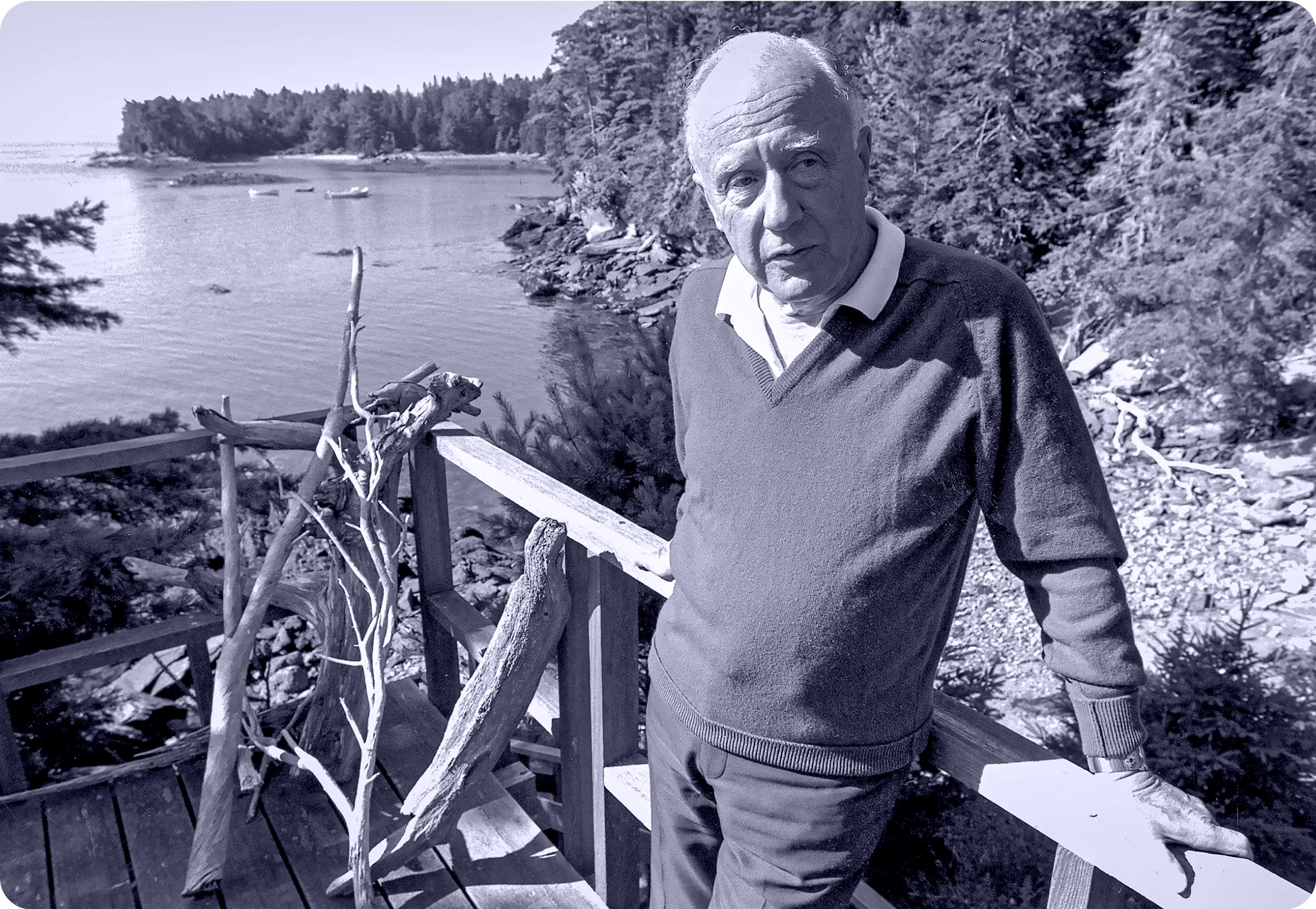
John Wheeler in Maine in the summer of 1985.
John Foraste; courtesy of Johns Hopkins University
He had come so far, discovering that space-time emerges from something deeper. Measurement by measurement, observers participate in the creation of their shared space-time. Or that was the idea. The trouble was that nothing in quantum mechanics enforces agreement among observers. If I measure a photon to be at some position, creating one stitch in the fabric of space-time in the process, that doesn’t ensure that the photon is in the same position for you. (Insisting that the outcome of my measurement does predetermine the outcome of yours would turn the photon’s position into a “hidden variable” of the type that experiments have already ruled out.) A stitch for one is not guaranteed to be a stitch for all.
“Observers independently participating … like 10,000 tinsmiths hammering away independently at 10,000 separate tasks,” he wrote in his journal. Why don’t they create 10,000 separate space-times? “What troubles me more than anything else is how different observers combine their impressions to build up what we call reality.”
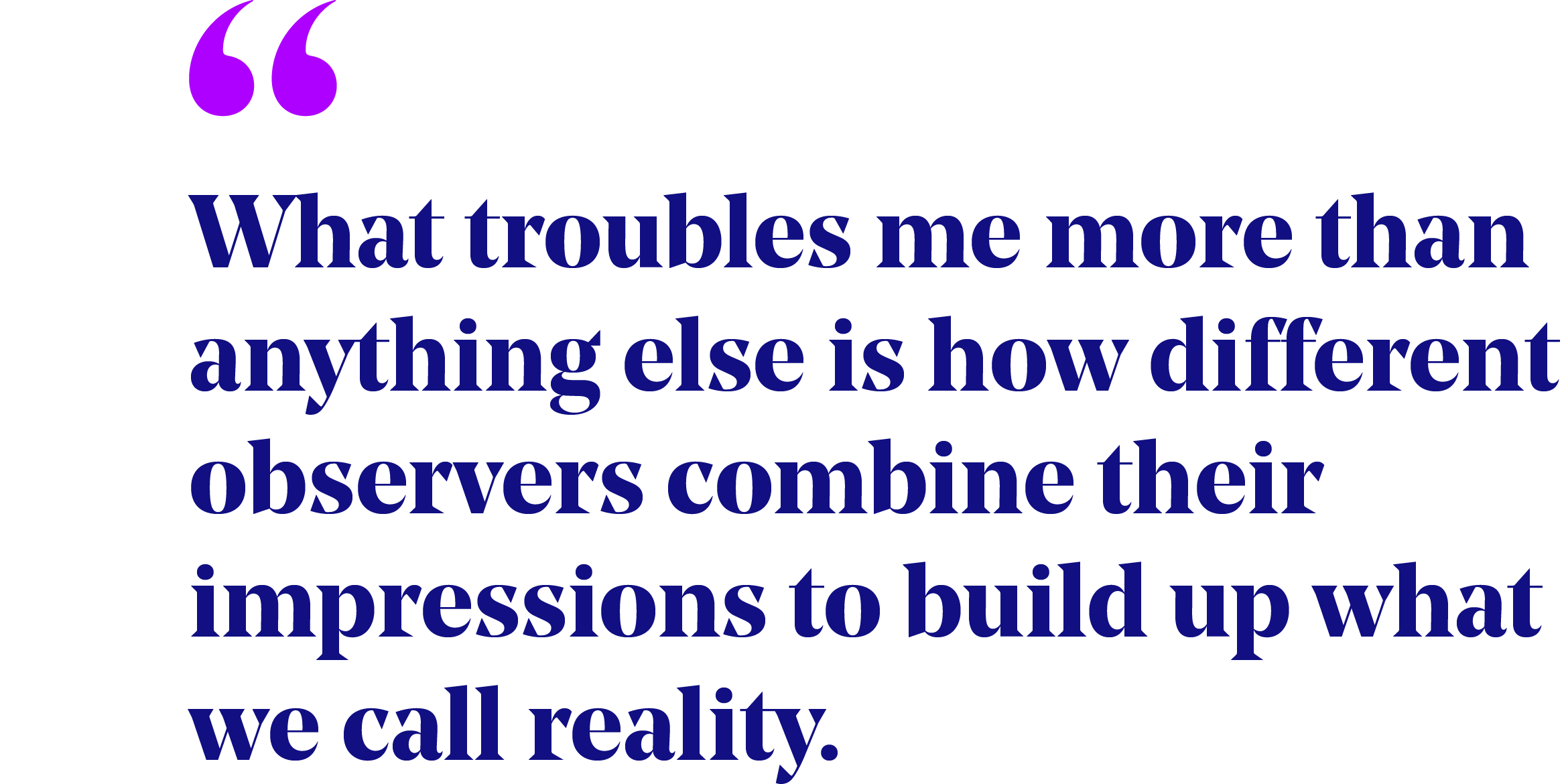
At first, Wheeler thought that observer-participancy involved consciousness. After all, tables and chairs don’t make choices about what to measure; conscious observers do. But that was of no help. He saw no way to link the private experiences of individual minds into a single, shared reality.
“On few issues in my life have I ever been more at sea than I am now on the relative weight of the individual and the collectivity in giving ‘meaning’ to existence,” he wrote. He remained at sea a few years later: “‘Consciousness’ seems to appertain to the individual. For my money the relevant concept should be a community property.” But what? In a participatory universe, one observer can ask a question and get an answer in response, and another observer can come along — tomorrow, next week, a billion years from now — and ask a different, incompatible question and get a different, incompatible answer. The universe can be shaped and reshaped in 10,000 ways by 10,000 tinsmiths, and nothing in the quantum formalism guarantees that they’ll ever agree.
Wheeler was distraught. For years, for pages, he obsessed. “I am not proud. I will confess all errors. I will try anything to crack the mystery.” After all, he wrote, “I owe it to the community to give my very best.” Any reality in which a thought, perception, or measurement outcome was someone’s private property was not a reality he could live in. At the same time, he couldn’t go back on a participatory universe. He couldn’t go back on pregeometry. “Is there any point partway between all and none on this issue?” he wondered. “Each of us a private universe? Preposterous! Each of us see the same universe? Also preposterous!”
So he was stuck. And he was running out of time.
“If we are the ones who ‘build’ the spacetime, how come we don’t get [as many] spacetime[s] as people,” he wrote on November 8, 2005. “How come just one? Pursue further that one.” He was 94.
The journal entries grew sparse.
What happens when you get to the end of things?
The last entry Wheeler ever wrote was in 2006, age 95, nearing death, his life now bookended by questions. It consisted of a single sentence, left behind for the community: “Hope produces space and time?”
